|
Sagrantino and Sangiovese, two famous grapes, the former exclusively associated
to Umbria and, in particular, Montefalco, the latter typically associated to
Central Italy, Tuscany and Emilia Romagna in particular. Sangiovese is also
cultivated in Umbria and, in most of the cases, it is blended to other grapes,
rarely vinified alone. Sangiovese is the absolute protagonist in monovarietal
red wines of Tuscany and Emilia Romagna, a leading grape for both regions.
Sagrantino is known for its richness in polyphenols, a characteristic resulting
in robust and astringent wines, something forcing producers to a strict
evaluation of polyphenolic ripeness of the grape and proper vinification. Also
Sangiovese is capable of making wines of remarkable structure, it is less
astringent and makes of crispness one of its main and appreciated qualities.
From a wine making point of view, Sangiovese is an evidently more versatile
variety than Sagrantino, with which are produced wines having different
characters and, sometimes, opposed. Sangiovese is in fact suited for the
vinification of many styles, from immediate and crisp wines, to robust and
complex results. Sagrantino too proved to have a certain versatility, even in
the production of classic method sparkling wines, however its richness in
polyphenols makes it more critical when used for the making of certain styles.
As opposed to Sagrantino, Sangiovese is widely spread and it is found in the
vineyard of many Italian regions, even in Sicily and Veneto. Sagrantino is a
variety specific to Umbria and, in particular, its presence outside the area of
Montefalco appellation is very limited and rare.
The origin of Sagrantino is not clear, a condition the grape of Montefalco has
in common with other varieties considered indigenous to Italy. There are many
theories about the origin of Sagrantino, however no one of them can be
considered reliable and certain, as there are no evident and historical
proofs about its origins. What can be considered certain is the long tradition
of Montefalco for viticulture and, in particular Bevagna, was mentioned by
Pliny the Elder in his important Naturalis Historia. In the past they
tried to identify Sagrantino with the ancient variety itriola -
sometimes called hirtiola - but it is very likely it was not the red
grape of Montefalco. Andrea Bacci associated Itriola to Passerina, whereas
other scholars, in particular archaeologist Carlo Pietrangeli, believed this
grape was Sagrantino. These hypotheses could not be proved, though.
Among the theories about the origin of Sagrantino, it is believed the grape was
introduced to Montefalco by some Franciscan monks coming back from Asia Minor.
This theory would also suggest the origin of the name as it seems Sagrantino
was used for the production of wine to be used in sacred rites. If it is true
the origin of the grape is not certain, what it is certain is the relationship
of Montefalco with viticulture and wine. The cultivation of the vine is in fact
dated back to the first century DC and, very important, Montefalco was one of
the few cities in Italy where the cultivation of the vine was done inside the
city walls. The importance of vine and wine in Montefalco became very high, as
in the sixteenth century harvesting was regulated by specific communal laws. It
can however be said at those times the presence of Sagrantino in Montefalco was
known and strong, its wines were already famous and appreciated in the near
Perugia and in Papal States.
The origin of Sangiovese is, for certain aspects, unclear and rich of
uncertainness. There are in fact two Italian regions disputing the origin of
Sangiovese: Emilia Romagna and Toscana, regions in which this variety is widely
common. The origin of the name is clearer and it is believed to derive from
sanguis Jovis - blood of Jupiter - and, in its many variations and
dialectal adaptations, today it is called Sangiovese. It is one of the most
important Italian varieties and of which exists many clonal expressions,
probably like no other grape. Researches about this variety introduced the
classification in two distinct families: Sangiovese Piccolo (Little
Sangiovese) and Sangiovese Grosso (Big Sangiovese), defined according
the size of berries. Sangiovese is called Prugnolo in the area of
Montepulciano, Brunello in Montalcino, both found in the province of
Siena, Tuscany.
Other names with which Sangiovese is known in Italy include: Morellino
in the Scansano area, province of Grosseto; Sangioveto in certain areas
of Tuscany; Nielluccio in Corsica, France. Wines produced with
Sangiovese are pretty variable, because both of the wide spreading in distant
and different places, and for the differences existing among the many clones. A
characteristic common to all Sangiovese wines is a certain elegance to the nose
and mouth, as well as a pleasing crispness, however perceptible in each of
them. From vinification in steel tanks to cask, Sangiovese has a unique and
interesting versatility, from immediate and direct wines, to complex and robust
interpretations. King of red wines of Romagna and Chianti, two of its most
famous expressions include Brunello di Montalcino and Vino Nobile di
Montepulciano.
|
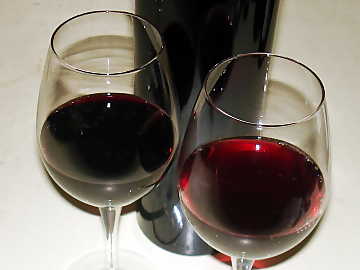 | |
| Contrasts of transparencies: on
the left Sagrantino di Montefalco; on the right Brunello di Montalcino | |
|
We will compare Sagrantino and Sangiovese in order to understand the
peculiarities of the two varieties by evaluating their differences. In order to
make the comparison even more useful, we will evaluate two wines having similar
wine making characteristics - or, at least, as similar as possible - therefore
simplifying the tasting. Choosing a Sagrantino is not difficult, as the wine
making technique used for its production is common to all of them: aging for at
least 33 months, of which 12 in wood. As for Sangiovese, we will need to chose
a wine aged in wood for a significant period, for this reason we will choose a
Brunello di Montalcino. Production disciplinary for this famous Tuscan wine
provides for an aging in wood for at least two years. In both cases, we will
choose wines aged in the same type of container, therefore cask or barrique.
We will begin by evaluating the appearance of both wines. The simple
observation of transparency let us notice an evident and substantial difference.
Sagrantino di Montefalco does not easily allow the passage of light and it will
be pretty hard to see an object put behind the glass. Brunello di Montalcino
has a higher transparency and, according to wine making and viticultural
conditions, the object put behind the glass will be easily recognized. Color
shows remarkable differences as well. Deep and intense ruby red in case of
Sagrantino di Montefalco, becoming brilliant and bright in Brunello di
Montalcino. Nuances of color generally tend to garnet red in the famous wine of
Tuscany, whereas in Sagrantino will be observed a strong ruby red nuance.
The nose too will reveal remarkable differences since the very first moments of
the olfactory evaluation. Two olfactory profiles characterized by quite
different opening although - for certain aspects - we can also perceive strong
analogies. Let's evaluate the opening of Sagrantino di Montefalco. By holding
the glass in vertical position and without doing any movement, let's proceed
with the first smell. We will perceive a strong and evident aroma of blackberry
- a primary and identifying characteristic of Sagrantino - as well as plum and
black cherry, including the elegant aroma of violet. Let's now evaluate the
opening of Brunello di Montalcino. The sensation perceived to the nose offers a
quite different olfactory profile. In this case black cherry and cherry will be
the main aromas, sensations which will be followed by plum and violet.
According to a general point of view, Sagrantino di Montefalco has a more
full and robust olfactory profile, whereas Brunello di Montalcino has a
fresher and thinner olfactory profile. In the great Umbrian red we will
mainly perceive aromas of black berried fruits, whereas in Brunello di
Montalcino will be red berried fruits to be mainly perceived. Moreover, in
Brunello di Montalcino it is not rare to perceive from the glass the aroma of
rose, including dried rose, a quality virtually unknown in Sagrantino di
Montefalco, except for very rare cases. Likewise, raspberry - pretty frequent
in many Brunello di Montalcino wines - is virtually unknown to the profile of
Sagrantino. We will not consider tertiary sensations, as they are strongly
connected to aging process, therefore variable according to time, keeping and
wine making.
To the taste, the two wines continue to prove their remarkable differences.
Sagrantino di Montefalco will be characterized, from the very moment it enters
the mouth, for its remarkable astringency and powerful structure. Full and
robust wine, Sagrantino is also characterized by a considerable quantity of
alcohol - it is in fact not uncommon to reach 15% - a quality useful for the
balance of its robust tannins. To the gustatory evaluation, Brunello di
Montalcino is characterized by a very different profile from Sagrantino. Also
in this case it is perceived a full and robust structure with an impact of
astringency lower and more moderate than the wine of Montefalco. If tannins are
less aggressive, the same cannot be said for the crispness caused by acidity,
in this case higher than Sagrantino.
An interesting characteristic to be considered is the difference of the concept
of structure in these wines. Both have a remarkable robust body, however the
expression of this quality is perceptible in different and distinct ways. In
Sagrantino di Montefalco polyphenols play, of course, a fundamental role: as it
is commonly known, this grape has a very high quantity of these substances. In
Brunello di Montalcino the impact of polyphenols is weaker than Sagrantino,
however it has a full and robust body. Wood plays a complementary and very
important role in both wines, as well as contributing to the enhancement of
overall roundness. In Sagrantino di Montefalco wood in fact contributes to the
balance of tannins' harshness; in Brunello di Montalcino it smooths any
possible excess of crispness determined by acidity.
|


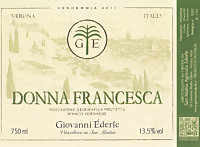
 Chardonnay, Garganega
Chardonnay, Garganega Intense golden yellow and nuances of golden yellow, very transparent.
Intense golden yellow and nuances of golden yellow, very transparent. Intense, clean, pleasing and refined, starts with hints of mature
apple, plum and honey followed by aromas of mature peach, banana, pear and
citrus fruits.
Intense, clean, pleasing and refined, starts with hints of mature
apple, plum and honey followed by aromas of mature peach, banana, pear and
citrus fruits.
 Crisp attack and however balanced by alcohol, good body, intense
flavors, pleasing roundness.
Crisp attack and however balanced by alcohol, good body, intense
flavors, pleasing roundness.
 Persistent finish with flavors of mature apple, plum and honey.
Persistent finish with flavors of mature apple, plum and honey. Aged in cask.
Aged in cask. Pasta with fish, Roasted fish, Roasted white meat, Stewed fish
Pasta with fish, Roasted fish, Roasted white meat, Stewed fish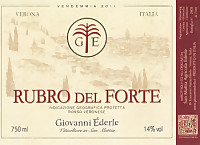
 Corvina, Corvinone, Rondinella, Croatina
Corvina, Corvinone, Rondinella, Croatina Brilliant ruby red and nuances of garnet red, moderate transparency.
Brilliant ruby red and nuances of garnet red, moderate transparency. Intense, clean, pleasing and refined, starts with hints of blackberry,
plum and dried violet followed by aromas of black cherry, tobacco, vanilla,
walnut husk and chocolate.
Intense, clean, pleasing and refined, starts with hints of blackberry,
plum and dried violet followed by aromas of black cherry, tobacco, vanilla,
walnut husk and chocolate.
 Properly tannic attack and however balanced by alcohol, good body,
intense flavors, pleasing roundness.
Properly tannic attack and however balanced by alcohol, good body,
intense flavors, pleasing roundness.
 Persistent finish with flavors of blackberry, plum and black cherry.
Persistent finish with flavors of blackberry, plum and black cherry. 12 months in cask, 12 months in bottle.
12 months in cask, 12 months in bottle. Roasted meat, Stewed meat, Braised meat, Hard cheese
Roasted meat, Stewed meat, Braised meat, Hard cheese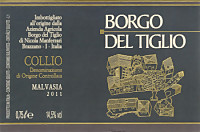
 Malvasia Istriana
Malvasia Istriana Intense greenish yellow and nuances of straw yellow, very transparent.
Intense greenish yellow and nuances of straw yellow, very transparent. Intense, clean, pleasing, refined and elegant, starts with hints of
apple, plum and hawthorn followed by aromas of pear, ripe peach, vanilla,
almond, caper, honey, grapefruit and mineral.
Intense, clean, pleasing, refined and elegant, starts with hints of
apple, plum and hawthorn followed by aromas of pear, ripe peach, vanilla,
almond, caper, honey, grapefruit and mineral.
 Crisp attack and however balanced by alcohol, good body, intense
flavors, pleasing roundness.
Crisp attack and however balanced by alcohol, good body, intense
flavors, pleasing roundness.
 Persistent finish with flavors of apple, plum and almond.
Persistent finish with flavors of apple, plum and almond. Ferments in cask.
Ferments in cask. Sauteed fish, Broiled crustaceans, Stuffed pasta with mushrooms
Sauteed fish, Broiled crustaceans, Stuffed pasta with mushrooms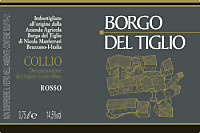
 Merlot, Cabrenet Sauvignon
Merlot, Cabrenet Sauvignon Intense ruby red and nuances of garnet red, little transparency.
Intense ruby red and nuances of garnet red, little transparency. Intense, clean, pleasing, refined and elegant, starts with hints of
black currant, black cherry and plum followed by aromas of blueberry, dried
violet, vanilla, chocolate, tobacco, licorice, mace, leather and
eucalyptus.
Intense, clean, pleasing, refined and elegant, starts with hints of
black currant, black cherry and plum followed by aromas of blueberry, dried
violet, vanilla, chocolate, tobacco, licorice, mace, leather and
eucalyptus.
 Tannic attack and however balanced by alcohol, full body, intense
flavors, agreeable.
Tannic attack and however balanced by alcohol, full body, intense
flavors, agreeable.
 Persistent finish with flavors of black currant, black cherry and plum.
Persistent finish with flavors of black currant, black cherry and plum. 2 years in barrique, 18 months in bottle.
2 years in barrique, 18 months in bottle. Game, Stewed and braised meat, Roasted meat, Hard cheese
Game, Stewed and braised meat, Roasted meat, Hard cheese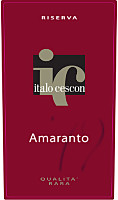
 Cabernet Sauvignon (40%), Merlot (35%), Cabernet Franc (15%), Marzemino (10%)
Cabernet Sauvignon (40%), Merlot (35%), Cabernet Franc (15%), Marzemino (10%) Deep ruby red and nuances of ruby red, little transparency.
Deep ruby red and nuances of ruby red, little transparency. Intense, clean, pleasing and refined, starts with hints of black
cherry, black currant and plum followed by aromas of violet, blueberry,
chocolate, vanilla, mace, tobacco and eucalyptus.
Intense, clean, pleasing and refined, starts with hints of black
cherry, black currant and plum followed by aromas of violet, blueberry,
chocolate, vanilla, mace, tobacco and eucalyptus.
 Tannic attack and however balanced by alcohol, full body, intense
flavors, agreeable.
Tannic attack and however balanced by alcohol, full body, intense
flavors, agreeable.
 Persistent finish with flavors of black cherry, black currant and plum.
Persistent finish with flavors of black cherry, black currant and plum. 12 months in barrique, 12 months in cask, 12 months in bottle.
12 months in barrique, 12 months in cask, 12 months in bottle. Game, Roasted meat, Braised and stewed meat, Hard cheese
Game, Roasted meat, Braised and stewed meat, Hard cheese
 Raboso
Raboso Deep ruby red and nuances of ruby red, little transparency.
Deep ruby red and nuances of ruby red, little transparency. Intense, clean, pleasing and refined, starts with hints of black
cherry, blackberry and plum followed by aromas of dried violet, blueberry,
vanilla, chocolate, mace and menthol.
Intense, clean, pleasing and refined, starts with hints of black
cherry, blackberry and plum followed by aromas of dried violet, blueberry,
vanilla, chocolate, mace and menthol.
 Tannic attack and however balanced by alcohol, full body, intense
flavors, pleasing crispness.
Tannic attack and however balanced by alcohol, full body, intense
flavors, pleasing crispness.
 Persistent finish with flavors of black cherry, blackberry and plum.
Persistent finish with flavors of black cherry, blackberry and plum. 36 months in cask, 12 months in barrique, 12 months in bottle.
36 months in cask, 12 months in barrique, 12 months in bottle. Game, Roasted meat, Braised and stewed meat, Hard cheese
Game, Roasted meat, Braised and stewed meat, Hard cheese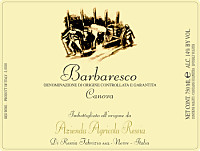
 Nebbiolo
Nebbiolo Brilliant ruby red and nuances of garnet red, moderate transparency.
Brilliant ruby red and nuances of garnet red, moderate transparency. Intense, clean, pleasing, refined and elegant, starts with hints of
cherry, plum and violet followed by aromas of raspberry, rose, vanilla,
tobacco, chocolate, cinnamon and menthol.
Intense, clean, pleasing, refined and elegant, starts with hints of
cherry, plum and violet followed by aromas of raspberry, rose, vanilla,
tobacco, chocolate, cinnamon and menthol.
 Tannic attack and however balanced by alcohol, full body, intense
flavors, pleasing crispness.
Tannic attack and however balanced by alcohol, full body, intense
flavors, pleasing crispness.
 Persistent finish with flavors of cherry, plum and raspberry.
Persistent finish with flavors of cherry, plum and raspberry. 26 months in cask, 6 months in bottle.
26 months in cask, 6 months in bottle. Game, Roasted meat, Braised and stewed meat, Hard cheese
Game, Roasted meat, Braised and stewed meat, Hard cheese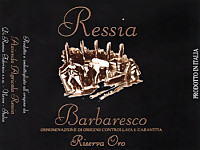
 Nebbiolo
Nebbiolo Brilliant ruby red color and nuances of garnet red, moderate
transparency.
Brilliant ruby red color and nuances of garnet red, moderate
transparency.
 Intense, clean, pleasing, refined and elegant, starts with hints of
cherry, plum and dried violet followed by aromas of raspberry, dried rose,
vanilla, tobacco, cocoa, cinnamon, licorice, leather, mace and menthol.
Intense, clean, pleasing, refined and elegant, starts with hints of
cherry, plum and dried violet followed by aromas of raspberry, dried rose,
vanilla, tobacco, cocoa, cinnamon, licorice, leather, mace and menthol.
 Tannic attack and however balanced by alcohol, full body, intense
flavors, pleasing crispness.
Tannic attack and however balanced by alcohol, full body, intense
flavors, pleasing crispness.
 Persistent finish with flavors of cherry, plum and raspberry.
Persistent finish with flavors of cherry, plum and raspberry. 5 years in cask.
5 years in cask. Game, Stewed and braised meat, Roasted meat, Hard cheese
Game, Stewed and braised meat, Roasted meat, Hard cheese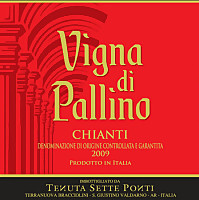
 Sangiovese
Sangiovese Intense ruby red and nuances of ruby red, moderate transparency.
Intense ruby red and nuances of ruby red, moderate transparency. Intense, clean, pleasing and refined, starts with hints of black
cherry, plum and violet followed by aromas of blueberry, raspberry,
blackberry and geranium.
Intense, clean, pleasing and refined, starts with hints of black
cherry, plum and violet followed by aromas of blueberry, raspberry,
blackberry and geranium.
 Properly tannic attack and however balanced by alcohol, good body,
intense flavors, pleasing crispness.
Properly tannic attack and however balanced by alcohol, good body,
intense flavors, pleasing crispness.
 Persistent finish with flavors of black cherry, plum and raspberry.
Persistent finish with flavors of black cherry, plum and raspberry. Aged in steel tanks.
Aged in steel tanks. Stewed meat with mushrooms, Broiled meat and barbecue, Cheese
Stewed meat with mushrooms, Broiled meat and barbecue, Cheese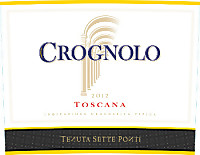
 Sangiovese (90%), Merlot (10%)
Sangiovese (90%), Merlot (10%) Intense ruby red color and nuances of ruby red, little transparency.
Intense ruby red color and nuances of ruby red, little transparency. Intense, clean, pleasing and refined, starts with hints of black
cherry, plum and black currant followed by aromas of violet, blueberry,
vanilla, tobacco, chocolate, mace and eucalyptus.
Intense, clean, pleasing and refined, starts with hints of black
cherry, plum and black currant followed by aromas of violet, blueberry,
vanilla, tobacco, chocolate, mace and eucalyptus.
 Tannic attack and however balanced by alcohol, good body, intense
flavors, agreeable.
Tannic attack and however balanced by alcohol, good body, intense
flavors, agreeable.
 Persistent finish with flavors of black cherry, plum and black currant.
Persistent finish with flavors of black cherry, plum and black currant. 14 months in barrique.
14 months in barrique. Roasted meat, Stewed meat, Braised meat, Hard cheese
Roasted meat, Stewed meat, Braised meat, Hard cheese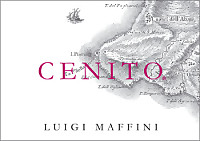
 Aglianico
Aglianico Intense ruby red and nuances of garnet red, little transparency.
Intense ruby red and nuances of garnet red, little transparency. Intense, clean, pleasing, refined and elegant, starts with hints of
plum, black cherry and blackberry followed by aromas of violet, blueberry,
black currant, vanilla, chocolate, tobacco, licorice and menthol.
Intense, clean, pleasing, refined and elegant, starts with hints of
plum, black cherry and blackberry followed by aromas of violet, blueberry,
black currant, vanilla, chocolate, tobacco, licorice and menthol.
 Tannic attack and however balanced by alcohol, full body, intense
flavors, pleasing crispness.
Tannic attack and however balanced by alcohol, full body, intense
flavors, pleasing crispness.
 Persistent finish with flavors of black cherry, plum and blackberry.
Persistent finish with flavors of black cherry, plum and blackberry. 18 months in barrique.
18 months in barrique. Game, Roasted meat, Stewed and braised meat, Hard cheese
Game, Roasted meat, Stewed and braised meat, Hard cheese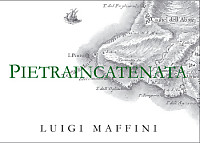
 Fiano
Fiano Brilliant straw yellow and nuances of straw yellow, very transparent.
Brilliant straw yellow and nuances of straw yellow, very transparent. Intense, clean, pleasing, refined and elegant, starts with hints of
apple, plum and hazelnut followed by aromas of citrus fruits, dried
apricot, almond, pear, vanilla, candied fruits, hawthorn, butter, honey,
flint and mineral.
Intense, clean, pleasing, refined and elegant, starts with hints of
apple, plum and hazelnut followed by aromas of citrus fruits, dried
apricot, almond, pear, vanilla, candied fruits, hawthorn, butter, honey,
flint and mineral.
 Crisp attack and however balanced by alcohol, good body, intense
flavors, pleasing roundness.
Crisp attack and however balanced by alcohol, good body, intense
flavors, pleasing roundness.
 Very persistent finish with long flavors of apple, plum and almond.
Very persistent finish with long flavors of apple, plum and almond. 8 months in barrique.
8 months in barrique. Roasted white meat, Roasted fish, Stuffed pasta, Fish soups
Roasted white meat, Roasted fish, Stuffed pasta, Fish soups
